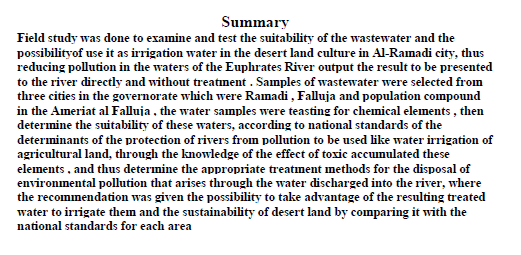Urban wetlands are one of the complex systems that provide many economic, social and environmental services to the city. In this research, the most important services provided by urban wetlands from the point of view of the urban planner were reviewed, and the types of these lands and their divisions according to the type of services provided by each type were presented. Environmental is represented in its ability to reduce the dangers of floods, mitigate the climate and reduce its negative impacts, purify water and deplete a lot of suspended impurities and pollutants, and social services such as recreational areas and beautiful landscapes that inspire joy and reassurance in the soul, as well as cultural areas and sports activities for m
... Show MoreThe researchers aim of this research to analyze the reality of educational services in the city of Ramadi in order to reveal the efficiency of the spatial distribution of schools at the level of residential neighborhoods and the requirements of the population, based on the standards and indicators for this service.
The research problem related to the educational function of the city of Ramadi was formulated by asking about the efficiency of the spatial distribution of educational services and whether there is a balance in the distribution of schools to residential neighborhoods in a way that meets the requirements of the population, and in order to answer the research problem, the research hypothesis was formulated that there is
... Show MoreThe aim of the research is the detection of heavy metals using (Inductively coupled Plasma ICP) for samples in Tigris river at intakes of water treatment plants Baghdad (Sharq dejla, Al-Wathba, Al-Wahda, and Al-Dora) and samples at Tigris banks near (Al-Adhamya, Al-Shuhda bridge and al-Jadrya).
All the recorded results were fitted with Iraqi standers No. 25 in 1967 for all samples with heavy metals (arsenic Ar, Cadmium Cd, Chromium Cr, Zinc Zn, Lead Pb, Copper Cu, Nickel Ni, Manganese Mn, Ferrous Fe) where all concentration were lower than standard values except Cadmium (0.01- 0.014) in plants intakes and (0.027- 0.048) in river samples while the standard value is (0.005).
Other tests such as chemical oxygen demand and oil &
The current research aims to adopt production quality decisions as the most important decisions , because they are accompanied by customer satisfaction through monitoring the quality of drinking water in iraq which reach through the pipeline network associated with water treatment projects of Tigris and Euphrates rivers. One of the indicators of quality control was the drawing of the C-chart by specifying the central line and the upper and lower limit of the control and the diagnosis of whether the production system as a whole within the scope of quality control or not and determine the strength and significance of the correlation between the quantities of water And actual needs for customers , the research has reached a number o
... Show MoreThis study is conducted to verify the efficienecy of local Ninivite rock when used in the treatment of drinking water in plants operating currently in the country in order to develop the situation of these stations to cope with the increase in population. Also, this will limit the pollutian which are increasing in the country's rivers.
(Euphrates and Tigris). These rivers are the sources to feed all water treatment plants in the country. The idea is the develop or the modify these stations by replacing part of top layer of sand filters used in these stations with Ninivite rock to operate as filters composed of two medium. The efficiency of this rock is compared with other materials used successfully worldwide in this area, such a
... Show MoreMicroalgae have been increasingly used for wastewater treatment due to their capacity to assimilate nutrients. Samples of wastewater were taken from the Erbil wastewater channel near Dhahibha village in northern Iraq. The microalga Coelastrella sp. was used in three doses (0.2, 1, and 2g. l-1) in this experiment for 21 days, samples were periodically (every 3 days) analyzed for physicochemical parameters such as pH, EC, Phosphate, Nitrate, and BOD5, in addition to, Chlorophyll a concentration. Results showed that the highest dose 2g.l-1 was the most effective dose for removing nutrients, confirmed by significant differences (p≤0.05) between all doses. The highest removal percentage was
... Show More (2)
(2)
The present paper aims at evaluating the vailability quality and future horizons of potable water in the city of Shatra as a model. This is done in accordance with certain subjective and objective factors alongside the classification map of Shatra as a residential area. This system follows geographical studies specialized in urban construction. The problem of the present paper as well as the data approaching that problem have been chosen from the records of 2018. The researcher offered (919) questionnaire forms to be answered by a sample of dwellers in that area. Besides, the researcher also followed lab analysis of water samples collected from districts in the city of Shatra. GIS technology was also used to arrive at the real water shar
... Show MoreUrban sustainable development is considered a critical tool to resolve the problem of the disappearance of architectural heritage. Departing from a basic knowledge about problems of urban sustainable development to maintain the monuments heritage minimizing the impact of genomics factors, and restore it according to its building materials and designs, and the rehabilitation of the urban fabric and heritage buildings, in order to revive the heritage of the building functionally or recycling of construction materials in the restoration of buildings and other operations in the removal procedure. The present study displays the plans, strategies and guidelines for sustainable heritage and its methodologies, as well as genuine solutions to pre
... Show More


